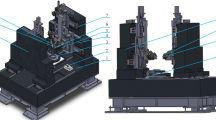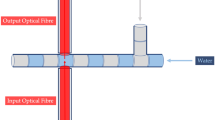Abstract
Because of small depth of field and small field of view of microscopic vision system in microassembly system, global morphologies, local features, and spatial states of trans-scale microparts and microgripper jaws in microassembly space cannot be observed and described simultaneously, which limits high-precision microassembly of trans-scale microparts. In this paper, a topological configuration of digital microassembly for microassembling microparts based on digital microassembly space as basic architecture of realizing different principles of digital microassembly is proposed. Accordingly, a principle of digital microassembly for realizing digital microassembly of hohlraum versus cone cavity is established based on digitalization principle of microassembly space and estimation method of microassembly position and orientation based on virtual digital microassembled target. The research results show that the topological configuration of digital microassembly of microparts based on digital microassembly space is the basic architecture of realizing different principles of digital microassembly. The constructed principle of digital microassembly can be used to realize the digital microassembly of hohlraum versus cone cavity with high accuracy. The estimation method of microassembly position and orientation based on virtual digital microassembled target can obtain microassembly position and orientation of hohlraum and cone cavity. And the digital pre-microassembly of hohlraum versus cone cavity can be used to analyze the assemblability of digital microassembly of hohlraum versus cone cavity. Therefore, digital microassembly of microparts based on digital microassembly space provides a novel method for realizing high-precision microassembly of microparts and lays a foundation for prospering microassembly technologies of microparts.
















Similar content being viewed by others
Data availability
The data can be provided by the corresponding author under reasonable requirements.
Code availability
The results in this article can be replicated via software MATLAB, CloudCompare, and LabVIEW.
References
Du K, Liu MF, Wang T, He XS, Wang ZW, Zhang J (2018) Recent progress in ICF target fabrication at RCLF. Matter Radiat Extrem 3(3):135–144
Qin FB, Shen F, Zhang DP, Liu XL, Xu D (2018) Contour primitives of interest extraction method for microscopic images and its application on pose measurement. IEEE Trans Syst Man Cybernet Syst 48(8):1348–1359
Yu H, Ai L, Rouhanizadeh M, Patel D, Kim ES (2008) Flexible polymer sensors for in vivo intravascular shear stress analysis. J Microelectromech Syst 17(5):1178–1186
Shayan M, Bhattacharjee S, Tang J, Chakrabarty K, Karri R (2019) Bio-protocol watermarking on digital microfluidic biochips. IEEE Trans Inf Forensics Secur 14(11):2901–2915
Zhou ZJ, Nie WR, Xu Z, Wang XF (2015) Electrical contact performance of MEMS acceleration switch fabricated by UV-LIGA technology. Microsyst Technol 10(10):2271–2278
Arab A, Feng QM (2014) Reliability research on micro- and nano-electromechanical systems: a review. Int J Adv Manuf Technol 74(9–12):1679–1690
Schwarz B, Ritt G, Koerber M, Eberle B (2016) Laser-induced damage threshold of camera sensors and micro-optoelectro-mechanical systems. Proceedings of SPIE Conference on Electro-Optical and Infrared Systems - Technology and Applications XIII, Vol. 9987, pp. 99870 (16pp)
Zhou J, Li PG, Zhou YH, Wang BC, Zang JY, Meng L (2018) Toward new-generation intelligent manufacturing. Engineering 4(1):11–20
Wang DH, Wang K, Qiang LS (2021) Depth estimation method of surface of micropart in microassembly space based on microscopic vision tomographic scanning images. J Microsc 283(2):77–92
Tao XD, Janabi-Sharifi F, Cho H (2009) An active zooming strategy for variable field of view and depth of field in vision-based microassembly. IEEE Trans Autom Sci Eng 6(3):504–513
Zhang ZT, Zhang J, Xu D (2013) Design of Microassembly System and Research on Coarse-to-Fine Alignment Strategy in combination with Active Zooming. 2013 IEEE Workshop on Robot Vision (WORV), Clearwater Beach, FL, USA
Zhang ZT, Xu D, Zhang J (2014) 3D Space Automated aligning task performed by a microassembly system based on multi-channel microscope vision systems. In: New Development in Robot Vision, Sun Y(Editor), Springer-Verlag Berlin Heidelberg 2014, 157–180
Qu YF, Zhang P, Hu YB (2018) 3D measurements of micro-objects based on monocular wide-field optical microscopy with extended depth of field. Microsc Res Tech 81(12):1434–1442
Ma YQ, Liu XL, Zhang J, Xu D, Zhang DP, Wu WR (2020) Robotic grasping and alignment for small size components assembly based on visual servoing. Int J Adv Manuf Technol 106(11–12):4827–4843
Tao XD, Cho H, Koh KC (2009) View planning to increase the visibility for observing micro objects using a variable view imaging system. Int Symp Optomechatronic Technol 299–304
Wu WR, Yu DH, Zhang L, Qiu ZR, Huang XH (2013) Development of a precision micro-assembly machine for ICF targets. Adv Mater Res 605–607:1431–1435
Ma YQ, Du K, Zhou DF, Zhang J, Liu X L, Xu D (2019) Automatic precision robot assembly system with microscopic vision and force sensor. Int J Adv Robot Syst 1–15
Lee D, Kim MY, Cho H (2015) Path planning for micro-part assembly by using active stereo vision with a rotational mirror. Sens Actuators A-Phys 193:201–212
Tamadazte B, Marchand E, Dembele S, Piat NLF (2010) CAD model based tracking and 3D visual-based control for MEMS micro-assembly. Int J Robot Res 29(11):1416–1434
Tamadazte B, Piat NLF, Dembele S, Marchand E (2009) Microassembly of complex and solid 3D MEMS by 3D vision-based control, in Processing of IEEE IROS. St. Louis, MI, USA, pp 3284–3289
Kudryavtsev AV, Laurent GJ, Clevy C, Tamadazte B, Lutz P (2015) Analysis of CAD model-based visual tracking for microassembly using a new block set for Matlab/Simulink. Int J Optomechatronics 9(4):295–309
Yesin KB, Nelson BJ (2005) A CAD model based tracking system for visually guided microassembly. Robotica 23:409–418
Matusek O, Hotar V, Laurent GJ, Tamadazte B, Clevy C (2014) Characterization of the positioning accuracy and precision of MEMS die servoing using model-based visual tracking. Appl Mech Mater 613:426–433
Wu WR, Bi L, Du K, Zhang J, Yang HG, Wang HL (2017) A new spatial angle assembly method of the ICF target. High Power Laser Sci Eng 5(2):13–18
Wang K, Wang DH, Zhao JY, Hou S (2022) A novel piezoelectric-actuated microgripper simultaneously integrated microassembly force, gripping force and jaw-displacement sensors: design, simulation and experimental investigation. Smart Mater Struct 31(1):015046
Wang DH, Yang Q, Dong HM (2013) A monolithic com-pliant piezoelectric-driven microgripper: Design, modeling, and testing. IEEE/ASME Trans Mechatron 18(1):138–147
Muhammad MS, Choi TS (2012) Sampling for Shape from Focus in Optical Microscopy. IEEE Trans Pattern Anal Mach Intell 34(3):564–573
Wang DH, Wang K, Wu ZM (2018) Pareto optimization-based trade-off between the visual resolvability and the intersection space of view of binocular microscopic vision system for microassembly systems. Opt Eng 57(5):053115
Quan SW, Ma J, Hu FY, Fang B, Ma T (2018) Local voxelized structure for 3D binary feature representation and robust registration of point clouds from low-cost sensors. Inf Sci 444:153–171
Yang JQ, Quan SW, Wang P, Zhang YN (2020) Evaluating local geometric feature representations for 3D rigid data matching. IEEE Trans Image Process 29:2522–2535
Wu ZM (2014) Research on key technologies of an automated microassembly system, Phd dissertation: Chongqing University, Chongqing, China
da Silva EHDR, Shinohara AC, de Lima EP, Angelis J, Machado CG (2019) Reviewing digital manufacturing concept in the Industry 4.0 paradigm. CIRP Conf Manuf Syst (CMS) 81:240–245
Funding
This work is supported by the National Natural Science Foundation of China (Grant No. 51675070, U21B2074), the Fundamental Research Funds for the Central Universities (Project No. 2018CDYJSY0055), and the LPMT, CAEP (Grant No. 2015–01-001).
Author information
Authors and Affiliations
Contributions
Kan Wang conceived research, completed the relevant experiments, analyzed the data, and wrote the manuscript; Li-Ping Bao participated in the revising of the manuscript; Dai-Hua Wang conceived research and participated in the writing and revising of the manuscript.
Corresponding author
Ethics declarations
Ethics approval
The article follows the guidelines of the Committee on Publication Ethics (COPE) and involves no studies on human or animal subjects.
Consent to participate
Not applicable. The article involves no studies on humans.
Consent for publication
Not applicable. The article involves no studies on humans.
Conflict of interest
The authors declare no competing interests.
Additional information
Publisher's Note
Springer Nature remains neutral with regard to jurisdictional claims in published maps and institutional affiliations.
Rights and permissions
Springer Nature or its licensor holds exclusive rights to this article under a publishing agreement with the author(s) or other rightsholder(s); author self-archiving of the accepted manuscript version of this article is solely governed by the terms of such publishing agreement and applicable law.
About this article
Cite this article
Wang, K., Bao, LP. & Wang, DH. Digital microassembly method for trans-scale microparts based on digital microassembly space. Int J Adv Manuf Technol 122, 2719–2744 (2022). https://doi.org/10.1007/s00170-022-09981-9
Received:
Accepted:
Published:
Issue Date:
DOI: https://doi.org/10.1007/s00170-022-09981-9




